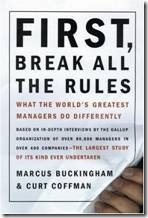It has been a few years now since I read First, Break All the Rules, but I remember it as one of those books that made an impression on me when I first read it, so I recently picked it up and skimmed it again. I still find it one of the more enlightening and thought-provoking leadership books that I have read. I won’t attempt to do a full review here, but want to highlight one key item.
 The book was based on extensive research done by the authors based on many years of polling employees and managers to see if they could discover any common themes around what good employees need in the workplace, and what good managers do to provide those things. In the course of their analysis they came up with a dozen questions that highly-engaged employees tended to answer positively while less-engaged employees did not. While drawing any conclusions from statistical correlations is always risky, these results are nevertheless interesting, at least to provide leaders with some points to reflect upon when judging their own leadership style.
The book was based on extensive research done by the authors based on many years of polling employees and managers to see if they could discover any common themes around what good employees need in the workplace, and what good managers do to provide those things. In the course of their analysis they came up with a dozen questions that highly-engaged employees tended to answer positively while less-engaged employees did not. While drawing any conclusions from statistical correlations is always risky, these results are nevertheless interesting, at least to provide leaders with some points to reflect upon when judging their own leadership style.
The 12 key questions are listed below at the bottom. Some of them might sound familiar, as we have seen some of them on employee opinion surveys (and I have seen them at other companies as well). But of the 12 questions, there is one that has remained etched in my mind: #4, which I will paraphrase as “Has someone (preferably your boss and/or someone else above you) complimented you on your work recently?”
I will be the first to admit that as a manager myself, I regularly fail to do this, so I’m making a “note to self” at this very moment!
It is hard to think of any action that is so easy and inexpensive to do, yet that has such a positive impact, as paying someone a compliment that reinforces something they have done well recently. The ROI on this must be near infinity.
As an employee, think of how you feel when your boss tells you how pleased he is with something you did recently. Only the most jaded employee would not fail to get a bit of a glow from this, the effect of which usually causes one to do even more of the same and do it even better.
Of course, like any feedback a leader provides to an employee, it is only useful if it is accurate and genuine. Hopefully that wouldn’t be too hard. Any employee who is performing at a level of “3” or better certainly must be doing things pretty well so it shouldn’t be hard to find something to compliment.
Conversely, if you just can’t find anything good to say to a given employee — well, that must mean something, too.
In an earlier post I wrote about adding energy to an organization. If you are a leader, here is a great way for you to do it. Maybe it will even cause your boss to compliment you on what a good job you are doing leading your team.
Appendix – Measuring the strength of a workplace
Here are the key questions which the most engaged employees will answer positively and others will not, according to the surveys done by the authors:
1. Do I know what is expected of me at work?
2. Do I have the materials and equipment I need to do my work right?
3. At work, do I have the opportunity to do what I do best every day?
4. In the last seven days, have I received recognition or praise for good work?
5. Does my supervisor, or someone at work, seem to care about me as a person?
6. Is there someone at work who encourages my development?
7. At work, do my opinions seem to count?
8. Does the mission/purpose of my company make me feel like my work is important?
9. Are my co-workers committed to doing quality work?
10. Do I have a best friend at work?
11. In the last six months, have I talked with someone about my progress?
12. At work, have I had opportunities to learn and grow?
Besides #4, others of these would make fine subjects for upcoming articles.
